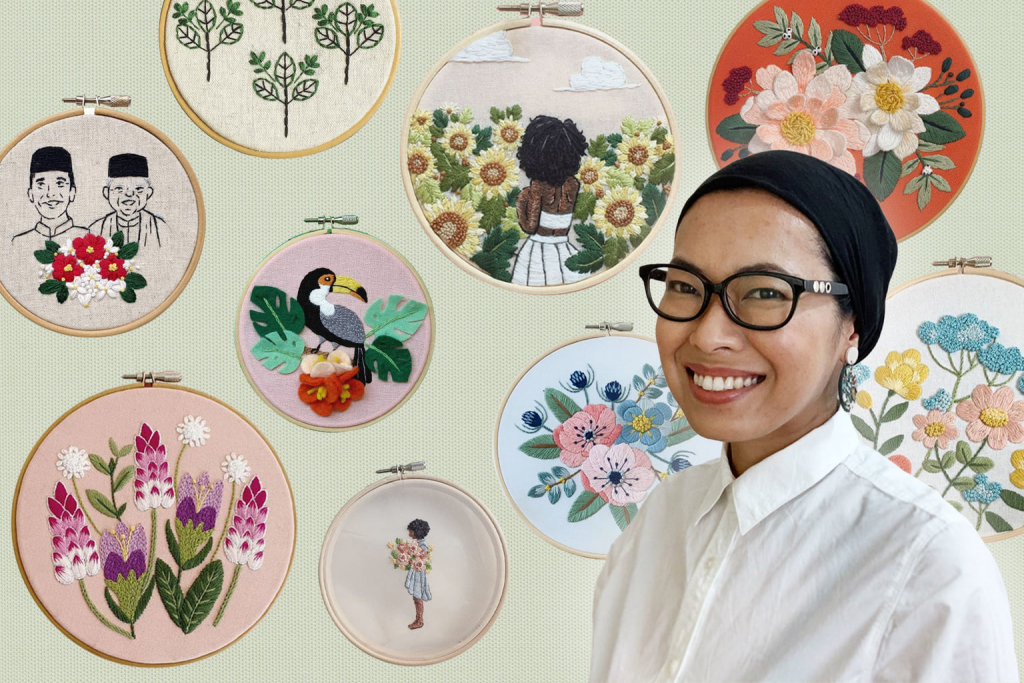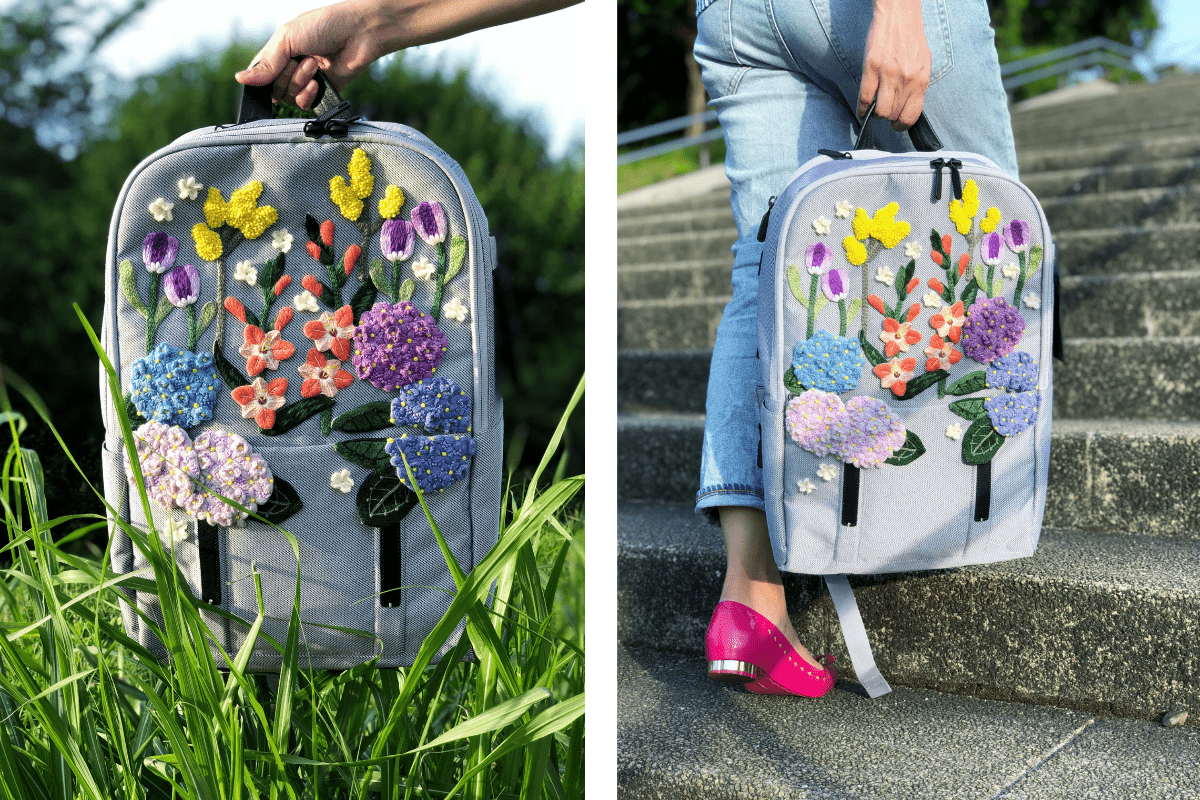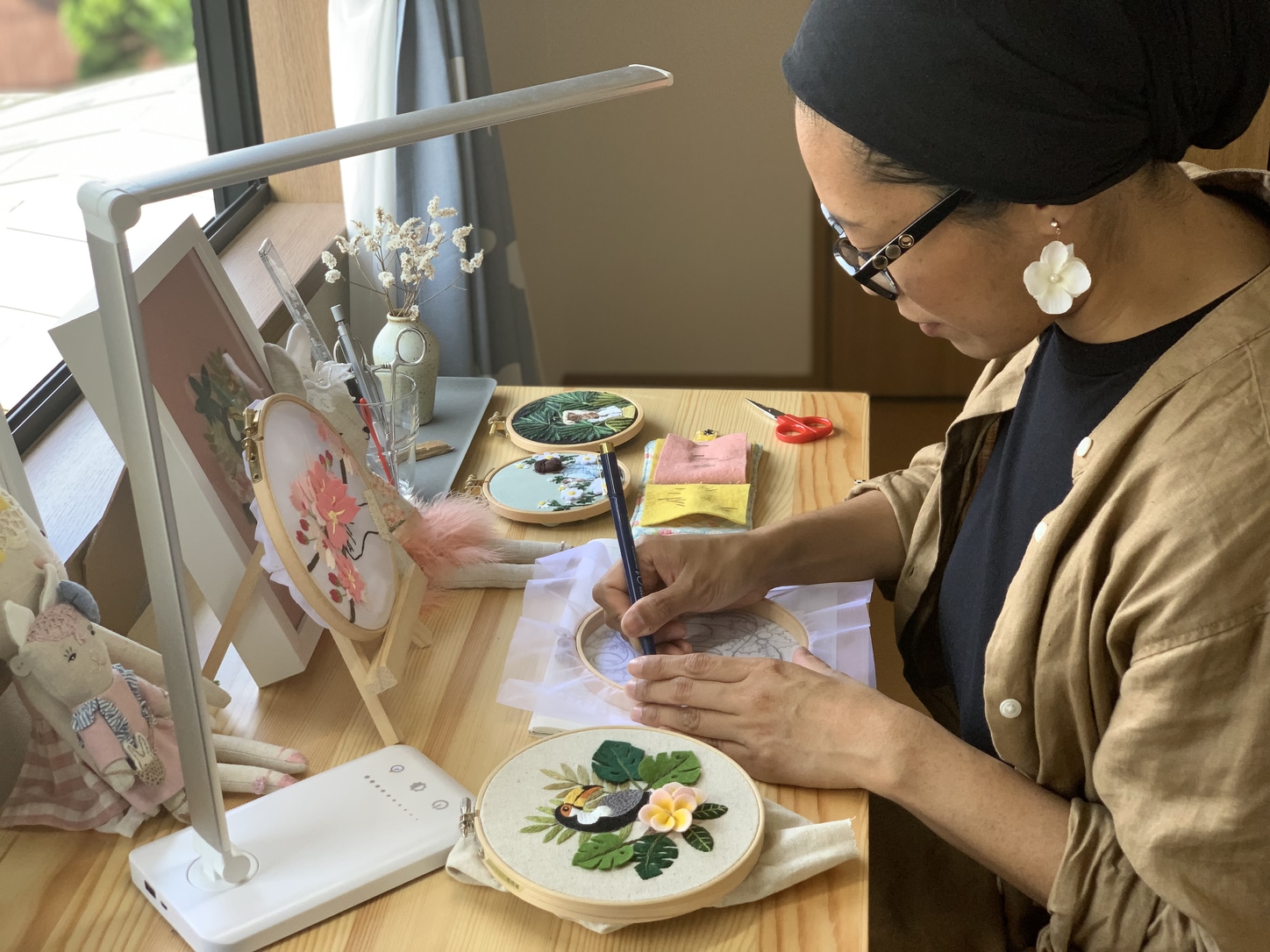It wouldn’t be a stretch to say that Ria Paramita’s personality embodies that of her craft. Her calm presence is multi-layered, with glimpses of charisma, empathy and fun. It’s been almost 10 years since she first moved to Japan. Since then, a chance trip to a craft store has seen her amass an online following for her quirky and personalized embroidery art. Over an iced coffee and matcha latte, we chat about slow art, the cultural differences between Indonesia and Japan and her plans for the future.
1. How did you first get into embroidery and what made you choose it as your medium of expression?
Back when I first arrived in Japan in 2012, I was lonely. I had my husband with me, but it was a common occurrence for him to be working past midnight. Some nights, he wouldn’t even be able to come home. My daughter too was enrolled at a Japanese school which meant long hours of study. Because of this, I would spend almost the entire day of every day alone.
To pass the time, I visited a craft store near where we lived. That was the start of me rediscovering my creative spirit. Initially I tried many things, like crocheting and paper cutting and I would simply follow the instructions provided. But when I picked embroidery, I found myself challenging each piece and getting excited at the outcome. That’s when I knew that embroidery would be different for me.
Embroidery is very soothing. The repetitive nature of it helps calm my mind. My favorite thing to do is to stitch while listening to a podcast. I just go into my own world.
2. What have been some of your biggest challenges since turning this from a hobby into your main venture?
When I became more confident in my work, I decided to try and sell it on Etsy (a global marketplace for unique and creative goods). It wasn’t easy. I had my Etsy store open for over six months before my first order came through. Etsy has an Editors’ Picks section on their website where they feature specific artists and their stores. My store was chosen to be featured, which was how my customers finally started to find me. The first order was a surreal but wonderful experience and I still remember that my first customer came from America.

I’m very grateful for each and every order I receive, but it was and still is challenging work. I did a lot of market research both on and off the Etsy platform and decided that I would make something really niche. I can’t stop copycats from imitating my art, but I can make it really unique so that it would be difficult to copy. That’s how I came up with custom family portraits made with a mixed medium of fabric dolls and hand-stitched embellishments. I noticed that drawings or paintings of family pictures were popular, so I wanted to do something within the same theme.
3. Where do you get your inspiration from?
A lot of my work is inspired by nature. The parks in Japan are very beautiful and you learn to appreciate how the landscape changes with each season. My family and I also really enjoy going hiking together in the mountains near our home. Stepping into nature, I can’t help but feel all of my problems melt away.
Even within the city, I try to find pockets of natural beauty. I really like Aoyama Flower Market for example and the way all of their entrances seem to be bursting with flowers.
4. What is the work you’re most proud of?
My most recent one. I was invited to collaborate with LOJEL, a global luggage brand aimed at modern travelers. Inspired by the season, I stitched a spring garden on their Urbo 2 Citybag. My garden features gladiolus, goldenrod, tulip, hydrangea and jasmine. Five different flowers, each with their own meanings such as strength of character, appreciation, growth and purity. In a Javanese wedding, it is also common to use fresh jasmine flowers in the bride’s headdress. The social campaign was to promote self-love and mental health, so I came up with a concept that included empowering flowers and strong symbolism.
5. What is your favorite type of embroidery?
There’s a huge variety of embroidery styles and techniques such as cross stitching and Swedish embroidery. It all depends on what you like and also what kind of materials you use. The style that I love and what I’ve been learning at Vogue Gakuen School in Tokyo is French embroidery. It’s my favorite because it’s very liberating. It feels more like painting but instead of using a brush or a pen, you go with a needle and thread.
6. What other creative projects have you been venturing into?
I recently spoke to someone who opened my mind towards what it means to be creative. Especially considering the line of work that I’m in. It’s not enough to open a store and expect sales to just pour in. A lot of it has to do with marketing, brand placement and how you want people to perceive your products. My hope with my embroidery is that it brings more awareness about this art form to my home country of Indonesia. I’d love to create my own embroidery kits to sell along with my own video tutorials on YouTube.
From a personal perspective, I’d like to draw from my experience as a young mom with a child. I’d like to help other women in my position and empower them through embroidery workshops. I think embroidery can be brought into the modern age and be accepted by younger generations as part of fashion or art. I’d also love to do more meaningful brand collaborations.
I’m very thankful for the support of my family, especially my husband. He’s always cheering me on to chase my own dreams and that’s been pivotal to me trying all these new things.
7. How has it been living in Japan as someone who is Indonesian?
Growing up in Indonesia, I was exposed to a lot of Japanese manga and anime such as Candy Candy, Mari-chan and Kungfu Boy (the name of Tekken Chinmi in Indonesia). They were all dubbed in Bahasa Indonesia. Even though life here is very unique, it also felt quite familiar in a way due to the proximity of Japanese culture to my upbringing. I feel such a fondness for Japan when I see my daughter walking to school on her own. I had that same experience growing up in Jakarta, back when it was safe to do so. It’s great that children here can be completely independent, walking, catching a bus or riding the train on their own.
The Japanese are very respectful. There are many rules, but everyone obeys them for the betterment of the community. They are also very aware of their surroundings and take great pains to ensure they do not inconvenience those around them. However, this results in a lot of nonconfrontational behavior which I find difficult to manage. Indonesians in contrast, have an ‘I am first’ mentality, but it does allow one to be more of an individual. There might be social pressures, but most people don’t care about adhering to them. Also if problems arise, it’s easy to speak to someone directly about it.
8. What are things Indonesians can learn from Japan and vice-versa?
One of the things that Indonesians can learn from the Japanese is to be on time. I’m really impressed with how much the Japanese value time. Not just with keeping appointments among friends but train schedules are very accurate. You can rely on them with confidence. In Indonesia there is a term called “jam karet” (literally “rubber time”) which we use for the majority of our people who tend to always be late or have a flexible view towards punctuality.
There’s a word in Bahasa Indonesia, “kehangatan,” which means to have a feeling of warmth, usually in your heart. I’d like to spread that message while I’m here because life in Japan can be very involved. It feels like everyone is always busy every day to the point where 24 hours in a day doesn’t feel like enough time. Maybe it’s because they’re usually very focused on their own lives and their own work.
9. Technology has seen society lean towards digital art as a form of expression. What do you think about the future of ‘slow art’ or art done with our hands such as embroidery?
Embroidery is not just an art form for me. It helps me psychologically and emotionally. Whether you make traditional art or digital art, there needs to be emotion in it. Art needs to invoke a response in the viewer and to connect people to the art or to others. It should have meaning.
When Etsy reposted my Girl in the Sunflower Fields piece, I received a lot of heartfelt comments from people all over the world. Some of them would write to me saying that the girl looks like their daughter or their teacher. There’s something so sincere in a response like that and I’m not sure that digital art can replicate it.
As someone who lives with anxiety, embroidery has been a very important outlet for me. There’s evidence that shows embroidery helps survivors of PTSD. It’s related to the way your hands move when you stitch. I think digital art is interesting and there’s a lot of conversations about illustrations made with mathematical formulas and artificial intelligence. But, for me, there’s no heart in that.
10. What advice would you give to someone who wanted to turn embroidery from a hobby into a career?
All creatives who want to build a sustainable life through art have to endure their craft. Whether you’re in the mood to create or not, it’s just something you have to do. Working based on a whim isn’t enough. I also like to think of the difference between design and art. Design requires you to think about the end-user, while art is for the ego. To be successful, I think you need both. At an entrepreneurship level, if you can hire people or collaborate with businesses to ‘outsource’ the non-creative aspects of your work, it makes life easier. Or you could be creative with a business-minded partner. For those who are strapped to a budget, you’ll just have to learn the different elements of how to run a business. It can be tough to build a new set of skills, but one should embrace it as part of the journey.
Ria is currently working on a hand embroidery tutorial book based on the four seasons. Follow her on Instagram or check out her Etsy store for her latest updates.
More interviews:













